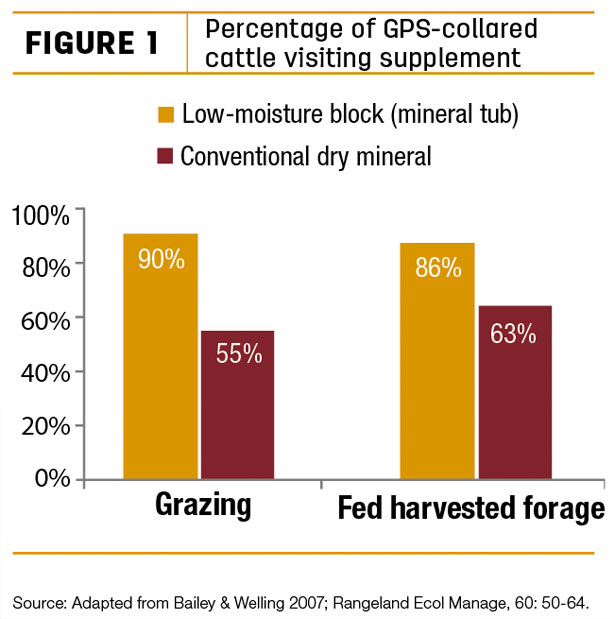What’s the most important part of your mineral program? It may not be the brand or the formulation – but rather how you manage it. The perfect mineral supplement probably does not exist, albeit the benefit of a good mineral program is well established, even if not fully understood.
Mineral nutrition can be a complex subject, and this complexity may be used as a sales tool to position product while overlooking other aspects of a program.
One topic, however, that’s grossly underestimated or underappreciated is mineral feeding management – especially in free-choice programs for grazing cattle.
Compromised mineral programs
The best-formulated mineral isn’t worth the bag it’s packed in if it isn’t consumed or managed correctly. It’s probably safe to assume a large percentage of mineral programs are compromised to some degree because of poor management or improper feeding.
This is unfortunate because considerable dollars can be invested in a mineral program, and if it’s not managed, it’s simply money wasted.
Some of the compromising factors in free-choice feeding systems include but aren’t limited to:
- Improper placement of minerals that may limit or give excess access to cattle
- Not having enough feeders for the number of animals
- Letting mineral supplement run out
- Not controlling waste due to weather
- Overdiluting minerals with salt or other ingredients
Intake variation
Variable intake of free-choice mineral is a reality and a challenge we should work to lessen. This variation can be due to environmental reasons such as diet, season, pasture conditions (forage availability), soil nutrients and stage of production, just to name a few.
Then there’s the individual animal variation – which is much harder to predict. There are a lot of studies that show how important mineral nutrition is and what the consequences of deficiency are, but few define individual animal variation.
When we feed a pen of cattle or a pasture of cows, we are really feeding for the average (average requirement, average intake, etc.). Most free-choice minerals are formulated for an average intake of 2 to 4 ounces per animal per day.
However, some studies show intake levels from zero ounces to over half a pound of daily intake. These highs and lows of intake may impact the efficiency and absorption of minerals. Additionally, individual animal variation could suggest some cattle are eating too much and others too little. I’ve heard it said by nutritionists and ranchers alike: “Half the cows are eating all the mineral.”
A study conducted at Montana State University addressed this topic. It compared the frequency of visits to a loose dry mineral, a low-moisture block mineral (molasses-based mineral tub) and salt. Overall, a much higher percentage of cattle consumed the low-moisture block mineral versus the dry loose form (Figure 1).

Additionally, some cattle did not eat any mineral or salt during the study period.
Getting consistency
Again, it’s impossible to have a “perfect” program, but with some simple commonsense management, most programs can be improved. Here are some tips:
1. Keep it simple. Feed companies have formulated thousands of mineral formulas and yet, at my company, roughly 20 percent make up 80 percent of the sales. Customization is nice but not always necessary and not always cost-effective.
Chances are your supplier has a good formulation in stock that meets most all requirements and will work just fine when fed properly. Don’t get overly set on a certain percentage of phosphorus, salt or other nutrient until you first understand the intake.
Cattle eat ounces and grams, not percentages. Sometimes customization is only used as a sales pitch or to justify an already known need.
2. Follow feeding directions on the tag. No matter the form of mineral, loose dry, block or tub, provide the proper number of feeding locations and amount placed. A common ratio suggested is one feeding station for every 20 to 30 head of animals.
This can vary based on the size of pasture or degree of confinement, but just like bunk space in a feedyard, the number of mineral feeding stations will affect how well, and by how many animals, mineral gets consumed. A common error that occurs is when only one mineral feeder or one tub is placed in front of 50 or more cows.
Location of the mineral is important, too. Placing it near watering or loafing areas generally gets cattle to consume more, and moving it away from said areas can reduce intake.
3. Consider mineral form and palatability. Most mineral fed to cattle is fed in a loose form. Loose minerals offer flexibility in formulation and are relatively easy to manufacture. Other forms, like small pressed blocks, offer convenience in placement, and tub products are gaining in popularity for a variety of reasons such as palatability, weatherability, pasture management, etc.
All forms have a place and can be effective. Some may fit better than others, especially when it comes to palatability or when dealing with situations where mineral intake (usually a lack of) is a concern.
For example, molasses-based block/tub supplements may work better in areas where naturally occurring salt or sodium is high in water or grass. Cattle may not eat loose mineral well under these conditions but may consume a tub product more readily.
Also, if a protein supplement is being fed, consider the mineral fortification of it, too. Often, when more than one free-choice supplement is being offered, intake on one of the two usually suffers. This is very true when feeding tubs; loose mineral consumption usually decreases.
So in this case, another mineral tub product may work better, or feed a tub that has a complete mineral fortification added as well.
4. Calculate intake regularly and watch the salt. Salt is technically a mineral and a required nutrient, but salt alone is not a mineral program. Trace mineral salt is not a complete mineral program either; it’s mostly salt (90 percent or more). Some minerals come with salt added, some don’t.
No matter how salt is being offered, it needs to be available. A very common practice is to mix additional salt with loose mineral at 1 to 1 or even higher to regulate intake. One precaution to take here is to be sure and know the overall intake so as to not dilute your program in half.
To summarize, mineral nutrition is complex, but feeding it doesn’t have to be. It can be simplified a great deal with good management. Don’t overanalyze a mineral program without considering management and how well and how many of your cows are consuming correctly. All feeding programs start with proper intake.
PHOTO: A good example of a mineral being overexposed to the elements, subjected to waste and becoming less palatable. Photo provided by Jon Albro.








